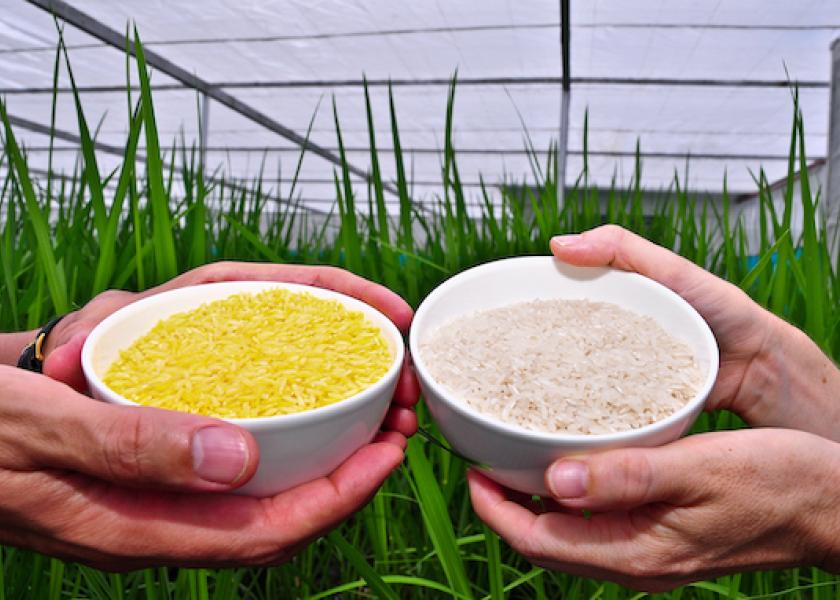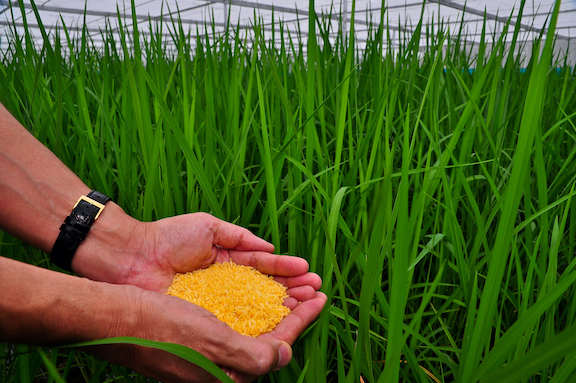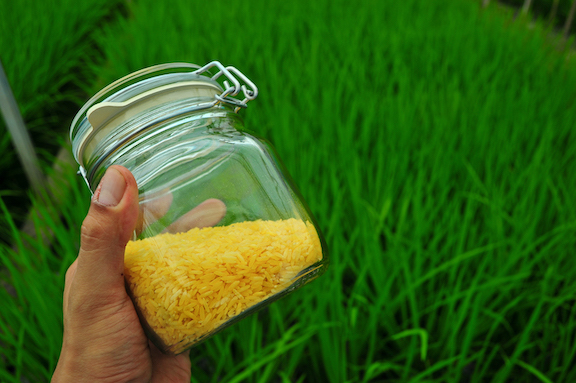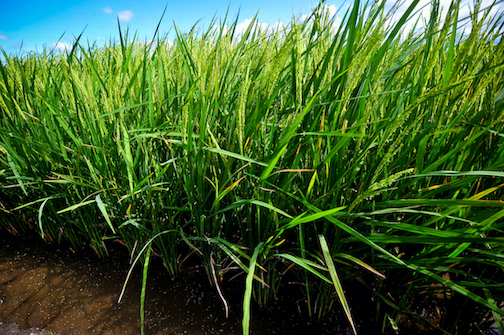Hostage to GMO Hysteria: Golden Rice Saga Lingers as Malnourished Suffer

What if a partial solution to the plight of millions of dying children was a mere bowl of grain, but the sustaining food was pushed away in the name of science? Welcome to the saga of Golden Rice.
Annually, roughly 250,000-500,000 children in Southeast Asia and Africa go from blindness to death caused by vitamin A deficiency (VAD). In a telltale pattern stemming from a lack of vitamin A, they first lose sight, then succumb to severe decimation of the immune system, and often die within 12 months. Even though 5.2 million children suffer with vision impairment and a potential death sentence, Golden Rice, a contributory answer to the global VAD malady, is not allowed to be sold in commercial seed sales—yet.
Since its initial development as a genetically-modified crop in the late 1990s, beta-carotene infused Golden Rice has faced waves of opposition from activist groups such as Greenpeace. Over 20 years and millions of VAD-related deaths later, the crop remains sidelined, despite enhancements and field testing. Whether Golden rice ultimately serves as a life-sustaining food source for poverty-stricken children, the denial of access to the distinctly yellow grain has been influenced by the anti-GMO activist pulpit.
Patrick Moore, a Greenpeace cofounder, and apostate from the organization’s current ideological positions, spoke plainly in 2016: “If Golden Rice were a cure for Ebola, malaria, or HIV-AIDS, it would have been approved years ago.”
The Trojan Horse
Despite the uproar from anti-GMO campaigners, Golden Rice presently is inching toward consumers in the Philippines, a remarkable advance, considering militants trampled and destroyed a Golden Rice field trial in the Southeast Asian country during 2013. Eight years later, on July 21, 2021, the Department of Agriculture Philippine Rice Research Institute issued a biosafety permit. Translated: Golden Rice can now be grown in the Philippines for commercial production, but market hurdles remain in place (varietal registration).

Even after two decades of claims and counterclaims, Golden Rice stirs a significant amount of confusion in the public eye, says Donald MacKenzie, executive director of the Institute for International Crop Improvement (ICCI) at the Donald Danforth Plant Science Center. “There’s a level of misinformation and lack of information on the state of Golden Rice. People think it’s already being grown for consumption, or they have no idea of its true status. The story of Golden Rice is a long one that people have heard in small pieces for 20 years.”
Approximately 3 billion people across the globe rely on rice as a main staple. In contrast with other staple crops, such as corn, wheat, or potatoes, rice lacks beta-carotene. (Yellow in color, beta-carotene is vital to the human body as a precursor of vitamin A production.) Consequently, vitamin A deficiency (VAD) often surfaces in rice-dependent countries.
Following a decade of research, two humanitarian scientists, Ingo Potrykus of Switzerland and Peter Beyer from Germany, inserted beta-carotene genes from daffodils and corn into rice DNA in 1999. Syngenta modified Golden Rice in 2005, using genes from corn and a beta-carotene producing bacterium. Syngenta gave sublicensing rights to the non-profit Golden Rice Humanitarian Board (GRHB), which provided Golden Rice to research institutions.
As Golden Rice research progressed, Greenpeace, GMWatch, Soil Association, and other advocacy groups cast the grain as fool’s gold. Greenpeace declared Golden Rice as a threat to health and food security: "…not only is GE ‘Golden’ rice an ineffective tool to combat VAD it is also environmentally irresponsible, poses risks to human health, and compromises food security."
Greenpeace opposition, MacKenzie says, is largely based in ideology. “Some people, for whatever reason, are opposed to the genetic engineering of crops. Therefore, they are opposed to Golden Rice. Of course, some in the opposition have posited that Golden Rice is the thin edge of a wedge, or a Trojan horse of more GM crops. I don’t subscribe to that belief and if Golden Rice can help save dying children and make their lives better off, then it is a worthwhile pursuit.”
Voices Carry
In the Philippines, 1.7 million children (aged 6 months to 5 years) are affected by varying VAD levels, according to the International Rice Research Institute (IRRI). A mere bowl and a half of Golden Rice can provide up to 50% of a child’s daily beta-carotene needs, cites MacKenzie. “The exact amount varies upon time of measurement, because just like in carrots or any other similar source, the amount of beta-carotene diminishes over time,” he notes. “If you measure the rice at harvest, the levels are 20-30 parts per million. Three months later it declines to 5-6 parts per million, depending on the variety of rice the trait has been bred into. Nonetheless, when you account for degradation and losses in cooking, children consuming a bowl and a half of Golden Rice per day could meet 30%-50% of estimated average requirements for vitamin A.”

Golden Rice is a complementary beta-carotene source, and not a silver bullet. A balanced diet is a cure-all for VAD, but beta-carotene deficiencies affect the poorest of the poor—those who can’t afford or don’t have access to proper dietary intake. Additionally, humanitarian organizations offer highly effective vitamin A pills to combat VAD, but medical supplements are dependent on logistics and budget.
“Golden Rice is a tool, and not the end-all, be-all for vitamin A deficiency,” MacKenzie emphasizes. “Governments already have vitamin A supplementation programs, but Golden Rice is an additional way to help dying children. Every means we have to prevent vitamin A deficiency is needed. There have been an incredibly large amount of disadvantaged people cast aside and propelled closer to blindless or death.”
Without consistent opposition from Greenpeace and other activist organizations, would Golden Rice be closer to market? “That’s a hard question to quantify categorically,” MacKenzie says. “Could we have had Golden Rice five years earlier? I don’t know, but certainly the opposition has made an impact. It tends to make decision and policy makers hesitant to come out and endorse or make a decision in favor of Golden Rice. It is a matter of perception, where influence is generated not by the number of voices, but by how loud the voices are. Other things have also slowed Golden Rice, but there’s no question that a small number of people in opposition get noticed.”
“The Health of Millions”
Resistance to genetic crop innovation is not isolated to Golden Rice. Cowpea and casava, both vital subsistence crops in Africa, have faced tremendous opposition from activist organizations.
In June 2021, pod borer resistant (PBR) cowpea gained market release in Nigeria and potentially could boost cowpea production in the country by “by 20-100%,” according to a Danforth Center release. Approximately 8 million Nigerian farming families will “benefit directly” from growing the new insect-resistant variety.

“The value of PBR cowpea is clear to farmers, and it’s highly effective in controlling legume borer which can decimate 80% of a crop,” MacKenzie says. “It is a genuine gamechanger.”
In Kenya, cassava with resistance to brown streak disease (CBSD), reliant on technology developed by the Danforth Center, is close to the national testing stage. CBSD is highly virulent and capable of inflicting 100% losses in a cassava crop. A third of Africa’s entire population relies on cassava roots for 50% of daily calories.
“Resistant varieties of cowpea and cassava have both faced heavy, organized opposition just because they involve genetic engineering,” MacKenzie adds. “What about the health of millions of lives at stake?”
The Poster Child
At present, Golden Rice is undergoing variety registration in the Philippines. If the process lasts another year, as MacKenzie hopes, the first varieties could be available to farmers in 2022. “Our vision is subsistence farmers growing Golden Rice for their own families, and others pushing it into the market for urban populations,” he explains.

Elsewhere, the Golden Rice Project is focused on Bangladesh. An application for cultivation of Golden Rice has stalled with Bangladeshi reviewers since the fall of 2017. Presently, no applications for Golden Rice are afoot beyond Bangladesh and the Philippines, but vitamin A deficiency is a significant problem in Sub-Saharan Africa, India, and other Southeast Asian countries.
Over two decades beyond the efforts of Potrykus and Beyer, Golden Rice waits. Has it been held hostage by hysteria? “At least in some degree,” MacKenzie contends. “It’s not the total solution to vitamin A deficiency, but it’s a major help where supplement programs and capsules don’t reach.”
“Whether all the arguments are right or wrong, Golden Rice has been the poster child for biotechnology for several decades,” MacKenzie concludes. “When you are the poster child, you are a lightning rod for the opposition. Bottom line, even though it has been blocked by so many people at so many levels, Golden Rice could be a partial remedy for a deadly problem faced by millions of dying children.”
To read more stories from Chris Bennett (cbennett@farmjournal.com), see:
Tractorcade: How an Epic Convoy and Legendary Farmer Army Shook Washington, D.C.
Bagging the Tomato King: The Insane Hunt for Agriculture’s Wildest Con Man
How a Texas Farmer Killed Agriculture’s Debt Dragon
While America Slept, China Stole the Farm
Bizarre Mystery of Mummified Coon Dog Solved After 40 Years
The Arrowhead whisperer: Stunning Indian Artifact Collection Found on Farmland
Where's the Beef: Con Artist Turns Texas Cattle Industry Into $100M Playground
Fleecing the Farm: How a Fake Crop Fueled a Bizarre $25 Million Ag Scam
Skeleton In the Walls: Mysterious Arkansas Farmhouse Hides Civil War History
US Farming Loses the King of Combines
Ghost in the House: A Forgotten American Farming Tragedy
Rat Hunting with the Dogs of War, Farming's Greatest Show on Legs
Misfit Tractors a Money Saver for Arkansas Farmer
Government Cameras Hidden on Private Property? Welcome to Open Fields
Farmland Detective Finds Youngest Civil War Soldier’s Grave?
Descent Into Hell: Farmer Escapes Corn Tomb Death
Evil Grain: The Wild Tale of History’s Biggest Crop Insurance Scam
Grizzly Hell: USDA Worker Survives Epic Bear Attack
Farmer Refuses to Roll, Rips Lid Off IRS Behavior
Killing Hogzilla: Hunting a Monster Wild Pig
Shattered Taboo: Death of a Farm and Resurrection of a Farmer
Frozen Dinosaur: Farmer Finds Huge Alligator Snapping Turtle Under Ice
Breaking Bad: Chasing the Wildest Con Artist in Farming History
In the Blood: Hunting Deer Antlers with a Legendary Shed Whisperer
Corn Maverick: Cracking the Mystery of 60-Inch Rows







